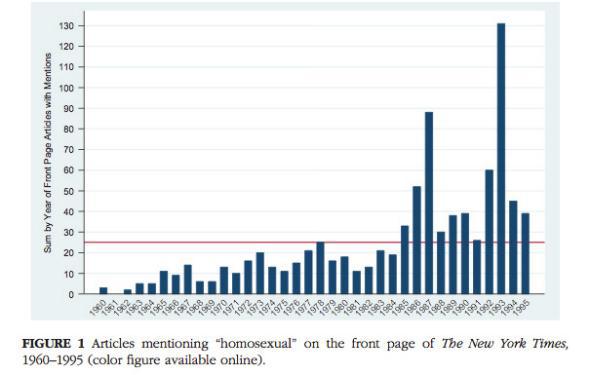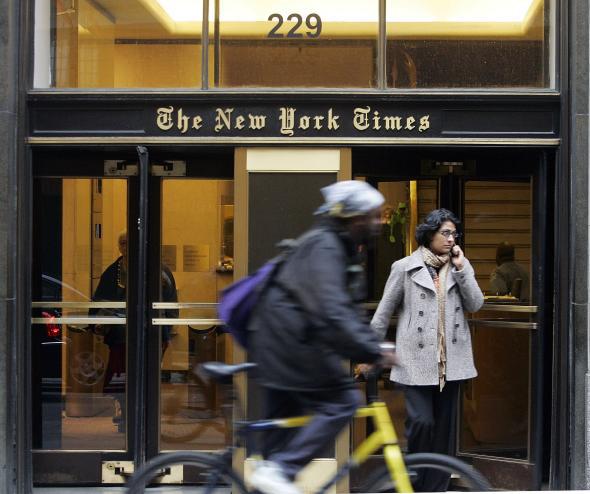In its obituary for the critic Stanley Kauffmann, who passed away this week at the age of 97, the New York Times discussed “Homosexual Drama and Its Disguises,” a now-infamous article he wrote in 1966, while working as the paper’s theater critic, about the dilemmas faced by gay male playwrights. According to the obit, “Many readers bristled at his analysis, taking it as an attack on homosexuals and saying it questioned the ability of gay playwrights to create authentic heterosexual characters.”
Kauffmann’s arguments certainly seem hopelessly dated today, but within the New York Times of 1966, his article caused controversy not for what it had to say about homosexuality, but for mentioning it at all.
As political scientists Daniel Chomsky of Temple University and Scott Barclay of Drexel University recount in a recent paper for the Journal of Homosexuality, Kauffmann’s mistake was not checking with his boss’s mother. Iphegene Sulzberger was “rabid on the subject” of homosexuality, according to a staff member at the time, and wrote a letter to her son, Arthur Ochs “Punch” Sulzberger, complaining about the article. “I thought you agreed with me that while homosexuality, like prostitution and social diseases, was now legitimate news, it should not be played on the front page of a section,” she wrote, speculating that “parents and grandparents” might be shocked by “all this talk of perversions.” Kauffmann was out as drama critic six months later.
This wasn’t the only time Iphigene’s views on the subject were made known to staff. Chomsky and Barclay note that the word gay, in reference to homosexuality, was explicitly banned by the Times in April 1975, after she complained about another article, this one highlighting the growing phenomenon of gay cruises.
The authors’ analysis of mentions of homosexuality in front-page Times articles, shown in the chart below, indicates that the subject was downplayed by the paper, at least until 1987:

Journal of Homosexuality
Stories that didn’t make the front pages during this period included the Stonewall riots of 1969; Britain’s and Canada’s contentious parliamentary debates over the legalization of consensual sodomy in 1967 and 1969, respectively; the American Psychiatric Association’s decision to declassify homosexuality as a mental disorder in 1973; and the early years of the AIDS crisis. AIDS didn’t appear on the front page of the Times until 1983, two years after it was first identified by the CDC. (A young cub reporter named Maureen Dowd was one of the earliest Times writers to cover the subject.)
So what changed in 1987? Well, partly, a series of national stories made front-page coverage of homosexuality unavoidable, including the news in 1985 that actor Rock Hudson was dying of AIDS; the 1986 Supreme Court sodomy case, Bowers vs. Hardwick; and Ronald Reagan’s first mention of the disease in 1987.
But Chomsky and Barclay argue that the bigger change was personnel shifts at the Times. Executive Editor Abe Rosenthal, who, later accounts suggest, had actively discouraged coverage of homosexuality, retired in 1986 and was replaced by the more sympathetic Max Frankel. The same year, “Punch” Sulzberger’s son Arthur Sulzberger Jr. was elevated to assistant publisher.
Chomsky and Barclay write:
The changes in ownership and management were quickly reflected on the news pages of the Times. A series on AIDS was published in March 1987 and featured prominently on the front page. Policies on obituaries were revised to include references to unmarried companions. The owners’ previous ban on the use of the word “gay” was officially lifted, and the word began to appear in front-page headlines. … In 1992, Arthur Sulzberger, Jr. officially became publisher of the New York Times, giving him nearly complete authority to set policy for the paper. The number of front-page stories soon reached unprecedented highs associated with the debate over gays in the military in 1993.
So, though she spent about 20 years missing one of America’s biggest stories, the Gray Lady did eventually get her act together.
